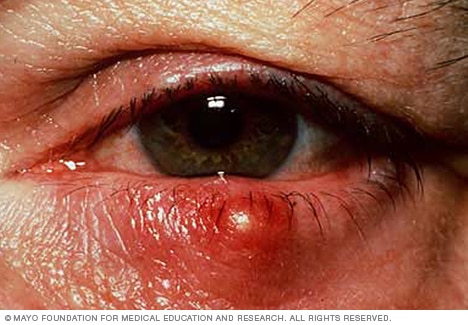Overview
A stye is a painful lump near the edge of the eyelid that may look like a boil or a pimple. Styes are often caused by bacterial infections and may be filled with pus. A stye usually forms on the outside of your eyelid, but sometimes it can form on the inner part of your eyelid.
In most cases, a stye will begin to disappear on its own in a couple of days. In the meantime, you may be able to relieve the pain or discomfort of a stye by applying a warm washcloth to your eyelid.

Stye
A stye is a bacterial infection involving one or more of the small glands near the base of your eyelashes. It is similar to a boil or a pimple and is often painful.
Symptoms
Symptoms of a stye include:
- A red or discolored lump on the eyelid that is like a boil or a pimple.
- Eyelid pain.
- Eyelid swelling.
- Tearing.
Another condition that causes inflammation of the eyelid is a chalazion. A chalazion happens when there's a blockage in one of the small oil glands near the eyelashes. Unlike a stye, a chalazion usually isn't painful and tends to be most prominent on the inner side of the eyelid. Treatment for both conditions is similar.
When to see a doctor
Most styes are harmless to the eye and won't affect the ability to see clearly. Try self-care measures first, such as applying a warm washcloth to your closed eyelid for 5 to 10 minutes several times a day and gently massaging the eyelid. Contact a healthcare professional if:
- The stye doesn't start to improve after 48 hours.
- Redness or discoloration and swelling involve the entire eyelid or extend into the cheek or other parts of the face.
From Mayo Clinic to your inbox
Causes
A stye is caused by an infection of oil glands in the eyelid. The bacterium staphylococcus is a common cause of most of these infections.
Risk factors
Factors that increase someone's risk of a stye include:
- Touching the eyes with unwashed hands.
- Inserting contact lenses without thoroughly disinfecting them or washing hands first.
- Leaving on eye makeup overnight.
- Using old or expired cosmetics.
- Having a long-lasting inflammation along the edge of the eyelid, called blepharitis.
- Having a skin condition characterized by facial redness, known as rosacea.
Prevention
To prevent eye infections:
- Wash your hands. Wash your hands with soap and warm water or use an alcohol-based hand sanitizer several times each day. Keep your hands away from your eyes.
- Take care with cosmetics. Reduce your risk of recurrent eye infections by throwing away old cosmetics. Don't share your cosmetics with others. Don't wear eye makeup overnight.
- Make sure your contact lenses are clean. If you wear contact lenses, wash your hands thoroughly before handling your contacts and follow your eye professional's advice on disinfecting them.
- Apply warm compresses. If you've had a stye before, using a warm compress regularly may help prevent it from coming back.
- Manage blepharitis. If you have blepharitis, follow your eye professional's instructions for caring for your eyes.